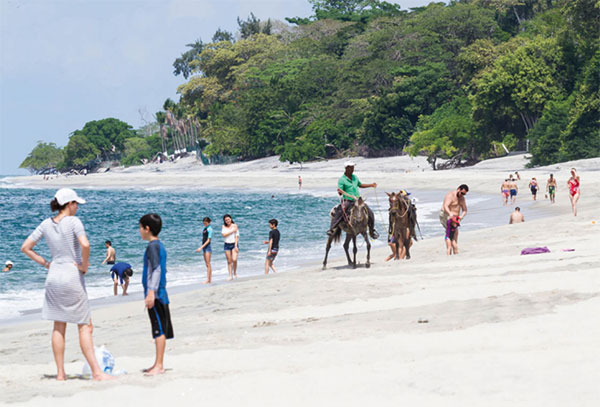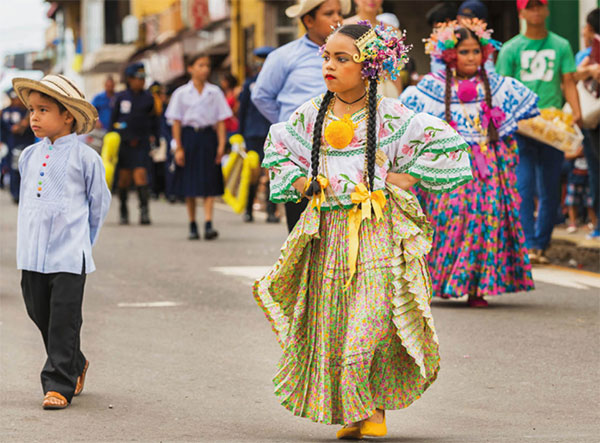Drink
Some mistake rum for Panama’s national drink. It’s not. That honor belongs to seco, a thrice distilled, 80-percent-proof sugarcane liquor. The most famous brand is Seco Herrerano, produced in the town of Pesé, by the Varela Hermanos distillery, which dates to 1936 and coincidentally also makes Abuelo rum. While inexpensive, top bartenders in Panama City have been experimenting with seco, often macerating it in native fruits.
Lush and green, the town and surrounding forests are a biodiversity hotspot and more than 350 species of birds have been recorded here. Cerro Gaital National Monument, on the northern hillside of town, has good hiking trails, including a 2–3 hour loop, where you can see both the Atlantic and Pacific Oceans from certain points.
There are dozens of B&Bs and ecolodges on the outskirts of town, including Canopy Lodge (www.canopytower.com/canopy-lodge/), which runs a zipline track farther up the hill, and the more resort-like Los Mandarinos Hotel and Spa (www.losmandarinos.com). For dining, there’s La Casa de Lourdes (www.lacasadelourdes.com), set inside an upscale Tuscan-style manor house, run by Lourdes Fábrega de Ward, a chef who studied with Martha Stewart and Paul Prudhomme and is something of a Panamanian culinary celebrity.

Tourists on the beach at Santa Clara.
Shutterstock
Azuero peninsula
Roughly 100km (60 miles) wide and 90km (55 miles) long, the Azuero peninsula is located just southward off the Pacific Coast, splitting the Gulf of Panama and the Gulf of Chiriquí. The rugged interior is defined by bare, rolling hills with grazing cattle and the occasional Spanish colonial house, while the pristine coastline is relatively undeveloped, although that is quickly changing. This is the folkloric capital of Panama, with a hard partying Carnaval and the finest makers of Pollera dresses.

Girls marching in a parade in Chitré wearing traditional pollera costumes.
Shutterstock
The largest town on the Azuero peninsula is Chitré ! [map] , which has a small airport with daily flights to Panama City. The town is of little interest, outside of amenities such as modern hotels and grocery stores that are severely lacking in other parts of Azuero. Outside of town is La Arena, an artisan village known for its ceramics, particularly the painted pots called tinajas.
Comprised mostly of whitewashed adobe houses with clay tile roofs, Las Tablas @ [map] is one of the most atmospheric towns in Azuero. For much of the year it is a sleepy place where there is little to do other than soak up the atmosphere…until Carnaval comes along. While the holiday is celebrated all over Azuero, in Las Tablas it is downright maniacal. Beginning on the Saturday before Ash Wednesday and continuing for four days consisting of parades, pollera contests, pageants, and, of course, heavy alcohol consumption. Throughout the event, the battle lines are drawn between Calle Arriba and Calle Abajo, which choose their own queens and try to out-do each other with floats and costumes. Water pistols, hoses, and buckets have become quite common, so visitors should plan on getting wet, whether they would like to or not.
The cowboy town of Pedasí £ [map] , driven by a young mayor who has encouraged the community to spruce up the local colonial houses, is becoming increasingly gentrified. There are new cafés and boutique hotels, although horses still far outnumber BMWs here. The town is the jumping-off point for the sudden surge of development on Playa Venao, about 12km (7 miles) away. With its long, curved beach and consistent waves, a new community is beginning to form, much of it from Israeli investments that are pumping cash into modern hotels like Villa Marina (www.villamarinalodge.com) amidst the surf camps and yoga retreats. On the south end of the beach, there’s the renowned restaurant Panga, run by an ex-Top Chef contestant who cooks over a wood fire, forages for local produce, and works with sustainable fisherman to create surprisingly sophisticated yet affordable meals.
Golfo de Chiriquí
Founded in 1994, the 14,730 hectares (36,400 acres) of Chiriquí Chiriquí Gulf National Marine Park $ [map] is where Panama is found in its most raw and wild form. The land, much of it displayed on uninhabited islets, is jagged and green, hiding big game fishing lodges and tiny resorts. In and along the water are mangroves, coral reefs, and white-sandy beaches. Huge schools of tropical fish, whales, and white-tipped sharks all come here to play in the sea, while migrating seabirds share the thick vegetation with howler monkeys and other wildlife.
The isolated fishing community of Boca Chica provides the best access to the park. Here, small hotels like Bocas del Mar (www.bocasdelmar.com), and nearby fishing lodges such as the Panama Big Game Sportfishing Club (www.panama-sportfishing.com) on Boca Brava island, set up packages where you can fish, kayak, whale-watch, or just lie on the beach.